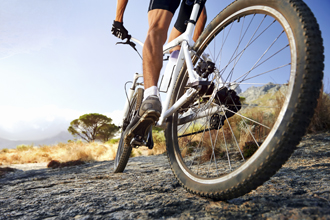Perfecting the Pedal Stroke
 For cyclists, there is much more to pedal stroke than simply making the cranks go round. Yet it is very difficult to determine what professional cyclists are actually doing just by watching them, especially given both the speed of the pedal itself and the almost invisible changes in the force applied to it. However, by making a few subtle changes to the pedaling movement, you can realize a huge difference in power and efficiency over time.
For cyclists, there is much more to pedal stroke than simply making the cranks go round. Yet it is very difficult to determine what professional cyclists are actually doing just by watching them, especially given both the speed of the pedal itself and the almost invisible changes in the force applied to it. However, by making a few subtle changes to the pedaling movement, you can realize a huge difference in power and efficiency over time.
Creating a Smooth Pedal Stroke
To begin with, in order to create a smooth pedaling stroke that allows the crank to turn round consistently, you need to pay attention to the direction of the force you are applying to the pedals. The easiest way to do this is to split a single rotation into four separate movements by picturing the circle of the pedal as a clock:
- The space between 1 o'clock and 5 o'clock is the downstroke, where most of the power comes from. The downstroke engages the thighs and gluts and is made stronger still with the combined forces of gravity and body weight.
- Between 5 o'clock and 7 o'clock is the pull back. During this movement, you apply force to the pedal stroke by pulling back with the leg. Cycling Secrets describes this sensation as trying to wipe something unpleasant off your shoe.
- From 7 o'clock to 11 o'clock is the lift-up quadrant. In this section, the leg lifts to the top of the pedal stroke. It should be lifting by using its own weight and not through the downstroke.
- Finally, between 11 o'clock and 1 o'clock is the set up for the next pedal stroke. In this movement, foot kicks forward to the start of the down stroke.
Your aim should be to ensure that each quadrant transitions seamlessly into the next with a consistent force in the direction of the stroke. You can best get a sense of how the sections should feel by spending time isolating each one. Before you integrate them together into a cohesive movement, though, you need to learn how each feels individually.
One of the best ways to gauge the smoothness of your pedal stroke is to use spinning or indoor cycling. Pedaling at the highest cadence possible will allow you to discover when the circle stops being smooth by noticing when you begin bouncing in the saddle.
In addition to this, you will want to work on experimenting with how differing pedal strokes create different feels; for example, you will want to adapt your pedaling for various conditions such as climbing and flat.
What Is Angling Pedaling?
Angling pedaling is a technique that engages the quads during the front of the pedal stroke and the muscles at the back of the thigh during the lift up. It is supposed to improve power and, therefore, efficiency. In angling pedaling, the heel comes down below the toe at the push down and above the toe on the lift up. This means you must apply a deliberate force to pull the pedal up into the top of the stroke rather than just using the leg to lift its own weight.
Some trainers recommend angling pedaling for increasing power, while others say that it is unhelpful as the metabolic cost of engaging the smaller muscles burns more energy than is produced. Cycling Secrets advises that the technique is good for creating power for small bursts of energy but is not good for endurance events.
Bringing your attention to your pedal stroke will enable you to improve the power and efficiency of your cycling practice. Contrary to what may seem self-evident, working on the tiniest movements is what makes the biggest differences.

